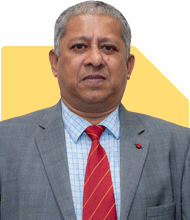Can a government school teacher with a 74,700 monthly salary manage these financial commitments?
Ramalingam Kalirajan |8369 Answers |Ask -Follow
Mutual Funds, Financial Planning Expert - Answered on Aug 08, 2024
He has an MBA in finance from the University of Madras and is a certified financial planner.
He is the director and chief financial planner at Holistic Investment, a Chennai-based firm that offers financial planning and wealth management advice.... more

Dear Sir, As a government secondary school teacher since 2016, my in-hand salary is ?74,700 after deductions for NPS (?8,500) . Here are the details of my annual and monthly financial commitments: Annual Expenses: - Health insurance: ?14,900 (for myself, my wife, and our 2-year-old daughter) - Term plan: ?22,000 (sum assured ?50,00,000) - SBI life insurance ?4,890 (sum assured ?28,00,000) - LIC: ?12,000 (sum assured ?2,50,000) Investments: - Mutual funds: ?1,76,000 till now - FD: ?50,000 Monthly Expenses: - Personal loan EMI: ?29,500 (32 installments remaining) - Rent and electricity: ?5,500 - Grocery and vegetables: ?5,000 - Baby expenses: ?4,500 - Petrol expenses: ?2,500 - Study expenses for my sister: ?6,000 - Study expenses for my brother: ?3,000 - Pocket money for my mother: ?2,500 Given these details, I am concerned about my ability to manage my finances effectively and meet all my commitments. I would greatly appreciate your advice.
Your current financial situation as a government secondary school teacher with a monthly in-hand salary of Rs 74,700 after NPS deductions requires careful planning. Let’s analyze your expenses, investments, and provide some recommendations for better financial management.
Annual Expenses
Health Insurance: Rs 14,900 for you, your wife, and your daughter.
Term Plan: Rs 22,000 with a sum assured of Rs 50,00,000.
SBI Life Insurance: Rs 4,890 with a sum assured of Rs 28,00,000.
LIC: Rs 12,000 with a sum assured of Rs 2,50,000.
Investments
Mutual Funds: Rs 1,76,000 invested till now.
Fixed Deposit: Rs 50,000.
Monthly Expenses
Personal Loan EMI: Rs 29,500 (32 installments remaining).
Rent and Electricity: Rs 5,500.
Grocery and Vegetables: Rs 5,000.
Baby Expenses: Rs 4,500.
Petrol Expenses: Rs 2,500.
Study Expenses for Sister: Rs 6,000.
Study Expenses for Brother: Rs 3,000.
Pocket Money for Mother: Rs 2,500.
Analysis
You have a high EMI which consumes a significant portion of your salary. Managing the remaining expenses with the leftover amount can be challenging. Your investments are diversified but could be optimized for better returns.
Recommendations
1. Prioritize Loan Repayment
Focus on Reducing EMI: Your highest expense is the personal loan EMI of Rs 29,500. Consider repaying this loan early to free up cash flow.
Evaluate Loan Refinancing: Check if you can refinance the loan for a lower interest rate or longer tenure to reduce monthly EMI.
Debt Management Plan: Create a debt management plan. Allocate any surplus income or bonuses towards loan repayment. This will help you reduce your debt burden faster and save on interest costs.
2. Optimize Insurance Plans
Health Insurance: Ensure that the current health insurance coverage is adequate. If not, consider enhancing the cover instead of buying a new policy.
Term Plan: Continue with the term plan as it provides substantial coverage for a low premium.
Review Life Insurance: Evaluate if the SBI Life Insurance and LIC policies are necessary. If they are endowment plans, consider surrendering and redirecting the funds to more efficient investment avenues like mutual funds.
3. Improve Investment Strategy
Increase Mutual Fund Investments: Given your long-term goals, increasing your SIP in mutual funds can be beneficial. Choose actively managed funds for higher returns over time.
Avoid Direct Funds: Direct funds require self-management and may lack the expert guidance you get from investing through an MFD with CFP credentials. Stick to regular funds for professional advice.
Focus on Diversification: Continue diversifying your investments. Consider equity, debt, and hybrid funds based on your risk profile.
Emergency Fund: Maintain an emergency fund equivalent to 6-12 months of your expenses in a liquid fund or savings account.
4. Budget and Expense Management
Create a Detailed Budget: Track your monthly expenses meticulously. Identify areas where you can cut costs, such as discretionary spending on groceries, petrol, or other non-essential items.
Monthly Review: Conduct a monthly review of your budget to ensure you are on track. Adjust your spending and saving patterns based on your financial goals.
Automate Savings: Set up automatic transfers to your savings and investment accounts to ensure consistent contributions.
5. Plan for Future Goals
Children’s Education: Start an education fund for your daughter. SIP in equity mutual funds is a good option for long-term goals.
Retirement Planning: Consider increasing your NPS contributions for additional tax benefits and a secure retirement corpus.
Short-Term Goals: For short-term goals like family vacations or home improvements, consider recurring deposits or short-term debt funds.
6. Consult a Certified Financial Planner
Professional Guidance: Regularly consult with a Certified Financial Planner to review and adjust your financial plan. They can provide personalized advice and help optimize your investment portfolio.
Regular Updates: Schedule regular updates and reviews with your financial planner to stay informed about market changes and new investment opportunities.
Impact of SEBI’s New Asset Class
Lower Entry Barrier: SEBI’s new asset class requires a minimum investment of Rs 10 lakhs, compared to Rs 50 lakhs for PMS, making it more accessible.
Broad Investment Mandate: This new class offers a wide range of investment strategies, similar to PMS, but at a lower cost.
Professional Management: Like PMS, the new asset class will be managed by experienced professionals, ensuring your investments are in good hands.
Flexibility and Diversification: Offers the flexibility and diversification of mutual funds, combined with the personalized approach of PMS.
Disadvantages of Index Funds
Passive Management: Index funds aim to replicate an index, limiting growth potential.
Market Performance: Index funds perform as well as the market. During downturns, they suffer losses.
Lack of Personalization: Index funds lack the personalized management found in actively managed funds and the new asset class.
Advantages of Actively Managed Funds
Professional Management: Actively managed funds have fund managers who make strategic decisions to outperform the market.
Flexibility: Fund managers can adjust the portfolio based on market conditions, aiming for better returns.
Potential for Higher Returns: Active management can potentially offer higher returns than index funds.
Disadvantages of Direct Funds
Self-Management: Direct funds require investors to manage their investments, which can be challenging without financial expertise.
No Advisory Support: Investors don’t get the support of a Mutual Fund Distributor (MFD) with CFP credentials, missing out on expert advice.
Advantages of Regular Funds
Expert Guidance: Regular funds offer the support of an MFD with CFP credentials, ensuring informed investment decisions.
Ease of Management: Investors benefit from professional management and regular updates, reducing the burden of self-management.
Final Insights
Balancing your financial commitments with your income requires careful planning. Prioritize paying off high-interest debt, optimize your insurance and investment strategies, and maintain a detailed budget. Regularly consulting with a Certified Financial Planner will ensure you stay on track to achieve your financial goals. By considering SEBI's new asset class, actively managed funds, and regular funds, you can enhance your investment strategy and secure your financial future.
Best Regards,
K. Ramalingam, MBA, CFP,
Chief Financial Planner,
www.holisticinvestment.in
You may like to see similar questions and answers below
Ramalingam Kalirajan |8369 Answers |Ask -Follow
Mutual Funds, Financial Planning Expert - Answered on May 18, 2024
Ramalingam Kalirajan |8369 Answers |Ask -Follow
Mutual Funds, Financial Planning Expert - Answered on Aug 13, 2024
Ramalingam Kalirajan |8369 Answers |Ask -Follow
Mutual Funds, Financial Planning Expert - Answered on Jan 29, 2025
Ramalingam Kalirajan |8369 Answers |Ask -Follow
Mutual Funds, Financial Planning Expert - Answered on May 15, 2025
Ramalingam Kalirajan |8369 Answers |Ask -Follow
Mutual Funds, Financial Planning Expert - Answered on May 15, 2025
Ramalingam Kalirajan |8369 Answers |Ask -Follow
Mutual Funds, Financial Planning Expert - Answered on May 15, 2025
Dr Nagarajan J S K |395 Answers |Ask -Follow
NEET, Medical, Pharmacy Careers - Answered on May 15, 2025
Dr Nagarajan J S K |395 Answers |Ask -Follow
NEET, Medical, Pharmacy Careers - Answered on May 15, 2025
Prof Suvasish Mukhopadhyay |648 Answers |Ask -Follow
Career Counsellor - Answered on May 15, 2025
Prof Suvasish Mukhopadhyay |648 Answers |Ask -Follow
Career Counsellor - Answered on May 15, 2025
Prof Suvasish Mukhopadhyay |648 Answers |Ask -Follow
Career Counsellor - Answered on May 15, 2025
Prof Suvasish Mukhopadhyay |648 Answers |Ask -Follow
Career Counsellor - Answered on May 15, 2025
Prof Suvasish Mukhopadhyay |648 Answers |Ask -Follow
Career Counsellor - Answered on May 15, 2025









.jpg)










